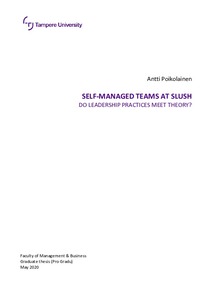Self-managed teams at Slush: Do leadership practices meet theory?
Poikolainen, Antti (2020)
Poikolainen, Antti
2020
Kauppatieteiden maisteriohjelma - Master's Degree Programme in Business Studies
Johtamisen ja talouden tiedekunta - Faculty of Management and Business
This publication is copyrighted. You may download, display and print it for Your own personal use. Commercial use is prohibited.
Hyväksymispäivämäärä
2020-05-25
Julkaisun pysyvä osoite on
https://urn.fi/URN:NBN:fi:tuni-202005034884
https://urn.fi/URN:NBN:fi:tuni-202005034884
Tiivistelmä
Competition in the modern business environment where businesses have an increased need for agility, innovation, and employee wellbeing, has fueled the search for alternate methods of organizing work compared to traditional hierarchical bureaucracy. Self-managing teams are one method of providing autonomy and a variety of benefits to teams and individuals, benefiting the organization.
In this paper, I provide an ethnographic perspective into leadership practices at a case study organization and how they relate to the theory of self-managing teams. The qualitative study used ethnographic material in the form of observations and obtained company material to develop an understanding of managerial and organizational practices employed at Slush. The almost yearlong observation process gave insights into how these practices work towards constructing or constraining leadership in self-managing teams.
During the study and analyzing literature, a total of 16 leadership practices were identified, which were used to interpret the results. These leadership practices of self-managing teams are: personnel selection, setting goals & expectations, planning & prioritizing, training & development, performance observation, practice & performance, problem-solving, defining mission, feedback & evaluation, challenging teams & encouraging selfmanagement, budgeting & resourcing, building team atmosphere & trust, motivating & inspiring, crisis management and sensemaking.
Out of these, the first seven practices were constructing, and the latter eight practices were constraining leadership of self-managing teams at Slush. No relevant observations for sensemaking were made and thus results are inconclusive. How these practices appear in the organizational context is discussed and elaborated. Several suggestions are made for the practitioners hoping to develop said practices into those more supportive of self-management.
Based on the findings, Slush was found to be employing self-managing teams. The teams have a considerable degree of autonomy and can engage in executing their work and autonomously setting priorities. Some limitations set by the organizational context, such as budgeting and strategy, are present. The exact degree of self-management is further explored through descriptions of each leadership practice employed within the organization.
Contributions to fields of leadership as a practice (process) and self-management were made. The framework presented can be used as a robust tool for designing and analyzing self-managed teams. A leadership practice of crisis management was discovered, which wasn’t identified in the literature studied. A suggestion for further use of ethnography as a means of studying leadership as a practice (process) and organizational culture is made.
Additionally, the research found that the field of self-management studies is evolving, and several new research avenues were identified. I suggest that the framework presented is used to analyze other organizations for identified variations in how self-managed teams choose to delegate the responsibility of recognized leadership practices. An invitation to critique the framework developed is made. Finally, I suggest applying a longitudinal method toward understanding if the benefits of self-managing teams can be enhanced if the recommendations made to practitioners are implemented.
In this paper, I provide an ethnographic perspective into leadership practices at a case study organization and how they relate to the theory of self-managing teams. The qualitative study used ethnographic material in the form of observations and obtained company material to develop an understanding of managerial and organizational practices employed at Slush. The almost yearlong observation process gave insights into how these practices work towards constructing or constraining leadership in self-managing teams.
During the study and analyzing literature, a total of 16 leadership practices were identified, which were used to interpret the results. These leadership practices of self-managing teams are: personnel selection, setting goals & expectations, planning & prioritizing, training & development, performance observation, practice & performance, problem-solving, defining mission, feedback & evaluation, challenging teams & encouraging selfmanagement, budgeting & resourcing, building team atmosphere & trust, motivating & inspiring, crisis management and sensemaking.
Out of these, the first seven practices were constructing, and the latter eight practices were constraining leadership of self-managing teams at Slush. No relevant observations for sensemaking were made and thus results are inconclusive. How these practices appear in the organizational context is discussed and elaborated. Several suggestions are made for the practitioners hoping to develop said practices into those more supportive of self-management.
Based on the findings, Slush was found to be employing self-managing teams. The teams have a considerable degree of autonomy and can engage in executing their work and autonomously setting priorities. Some limitations set by the organizational context, such as budgeting and strategy, are present. The exact degree of self-management is further explored through descriptions of each leadership practice employed within the organization.
Contributions to fields of leadership as a practice (process) and self-management were made. The framework presented can be used as a robust tool for designing and analyzing self-managed teams. A leadership practice of crisis management was discovered, which wasn’t identified in the literature studied. A suggestion for further use of ethnography as a means of studying leadership as a practice (process) and organizational culture is made.
Additionally, the research found that the field of self-management studies is evolving, and several new research avenues were identified. I suggest that the framework presented is used to analyze other organizations for identified variations in how self-managed teams choose to delegate the responsibility of recognized leadership practices. An invitation to critique the framework developed is made. Finally, I suggest applying a longitudinal method toward understanding if the benefits of self-managing teams can be enhanced if the recommendations made to practitioners are implemented.
